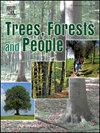Hiding in plain sight: Reinvasion risk from retained seed after dispersal events in introduced conifers
IF 2.7
Q1 FORESTRY
引用次数: 0
Abstract
Non-native conifers are the most successful tree-weeds in the Southern Hemisphere, reproducing annually through seed-bearing cones. Rather than shedding cones, some conifer species retain cones on the tree indefinitely (e.g. Pinus contorta), meaning cones persist on the tree even after mortality via common foliar applied herbicide-based control methods. We investigated whether open cones could present a reinvasion risk by retaining seeds after their primary dispersal event and disseminating them over time. We found that 19 % of open cones retained viable seed after opening, with an average of 3.5 viable seeds (ranging from 1-39) per cone. The oldest cone retaining viable seed was 15 years old. The majority of seeds had separated from their wing 6 years after the initial cone opening, however intact wings were recovered up to 11 years post cone opening. These results suggest that cones can still contribute to propagule pressure even after their main dispersal event, potentially leading to the reinvasion of sites years after control operations. However, as the majority of seeds detach from their wings only a few years after cone opening their dispersal ability is hampered and reinvasion would likely occur close to the parent tree.
隐藏在显而易见的地方:在引进的针叶树中散布事件后保留种子的再入侵风险
非本地针叶树是南半球最成功的树杂草,每年通过有种子的球果繁殖。一些针叶树物种不会脱落球果,而是无限期地将球果保留在树上(例如松),这意味着即使在死亡后,球果仍然存在于树上,通过常见的叶面施用除草剂控制方法。我们调查了开放球果在初次传播后保留种子并随着时间的推移传播是否会带来再入侵的风险。结果表明,开放球果中有19%的球果在开放后仍有活籽,平均每个球果有3.5颗活籽(1 ~ 39颗)。保留可存活种子的最老球果为15岁。大多数种子在最初的球果打开后6年与翅膀分离,但在球果打开后11年恢复完整的翅膀。这些结果表明,即使在它们的主要扩散事件发生后,球果仍然可以贡献繁殖压力,可能导致控制操作后数年的再次入侵。然而,由于大多数种子在球果打开后仅几年就从翅膀上脱落,它们的传播能力受到阻碍,并且可能在靠近母树的地方再次入侵。
本文章由计算机程序翻译,如有差异,请以英文原文为准。
求助全文
约1分钟内获得全文
求助全文
来源期刊

Trees, Forests and People
Economics, Econometrics and Finance-Economics, Econometrics and Finance (miscellaneous)
CiteScore
4.30
自引率
7.40%
发文量
172
审稿时长
56 days
 求助内容:
求助内容: 应助结果提醒方式:
应助结果提醒方式:


